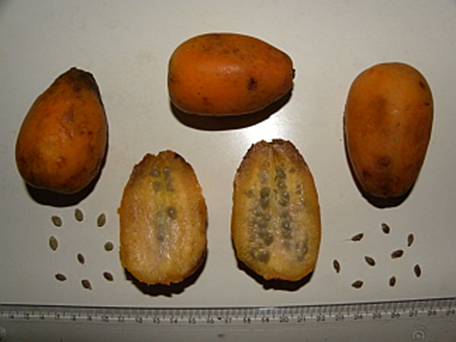JACARATIA DODECAPHYLLA
FAMILY OF CARICACEAE

NOMEMCLATURE AND SIGNIFIANCE: JARACATIÁ-MAMÃO comes from the Tupi word meaning "fruit of the soft stem or stalk." Also referred to as Mamão do mato, Jaracatiá Branco (because of the pulp).
ORIGIN: Semi-evergreen forests of higher atitudes, is very rare in the states of Minas Gerais, São Paulo and Paraná, Brazil. More information in Portuguese at the link:
NOTES: Botanists do not classify Jacaratia dodecaphylla as species, is currently classified as a botanical synonymy of Jacaratia spinosa. But in my opinion, strain characteristics, the leaves, fruits and seeds are a compelling basis for delineation and separation of the species. My conclusion is, to make a long overdue revision of the genus Jaracatia in Brazil..
FEATURES:
Propagation: The seeds are small and are able to germinate over a year if kept dry and clean in dark containers. I recommend sowing in boxes of 16 cm width, 20 cm height and 40 cm in length with rich organic matter substrate. Germination takes place after 30 to 40 days and the seedlings can be separated into individual pots when they are 10 to 15 cm high. The seedlings grow rapidly and can reach 40 cm with 5 to 6 months after planting. Propagation by cuttings from mature shoots with diameter of 3.5 cm can be done in greenhouses with high temperatures and humidity.
Planting: Culture in full sun, dig holes 50 cm in three dimensions at a distance of 5 x 5 or 6 x 6 m and fill 30 cm with 6 shouvels well mixed manure plus 500 g of lime and 1 kg of wood ash and leave for 2 months to act. The best planting time is from October to November and pour after planting with 10 liters of water every 15 days during the first year if it is not raining.
Culture: The plant does not need special treatment, remove only crossing and diseased shoots. The fertilization with organic compost is sufficient, it can scoop four poultry manure mixed well with 30 g NPK 10-10-10, the twice amount until third year, then only the simple quantity, distributed in the distance of 40 cm from the stem.
Use: The fruit ripe from February to April. the fruits have whitish yellow pulp, the taste is reminiscent of papaya and mango containing little latex, which can burn the lips and tongue in some sensitive individuals. Therefore only harvest the fruits when they are fully colored orange and eat them 3 or 4 days later, so that this effect does not happen again. Another delicious way to eat fruits roasting over coals as the Indians did. Can also be used to prepare juices and sweets. The trunk is used to make a sweet candy bar, so that the tree is becoming increasingly rare.
Back to the seedlist (English) or back to Caricaceae (Portuguese)